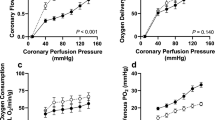Summary
The effect of metabolic and hypercapnic acidosis on myocardial blood flow was studied during intravenous infusions of hydrochloric acid solutions (n=12) and during passive ventilation with 5% CO2 (n=5) in anaesthetized, closed chest dogs. Below a pH of 7.2 metabolic acidosis at normal arterial CO2-tensions caused an increase of coronary blood flow and a decrease of coronary vascular resistance associated with a narrowed myocardial arteriovenous O2-difference, indicating vasodilation at unchanged myocardial oxygen consumption. In propranolol-pretreated dogs myocardial blood flow and coronary oxygen AV difference remained unaffected, suggesting that the coronary dilatory effect of metabolic acidemia involves beta adrenergic stimulation. Coronary vasodilation induced by increasing arterial pCO2 was found to the significantly greater as compared with the dilatory effect of metabolic acidosis at the same blood pH level. Blocking of beta receptors did not reduce the coronary response to increased arterial CO2-tensions. It is concluded that the coronary vasodilation observed during hypercapnic acidosis is neither mediated by a beta adrenergic stimulation nor dependent of the concomitant change in blood pH. The possible sites of the coronary dilatory actions of increased arterial CO2-tensions are discussed.
Zusammenfassung
An intakten Hunden wurde der Einfluß einer isolierten metabolischen Azidose (HCl-Infusion, n=12) auf die Myokarddurchblutung mit den Koronarwirkungen einer durch Hyperkapnie induzierten Azidose (Beatmung mit 5% CO2, n=5) unter den Bedingungen einer Allgemeinnarkose verglichen. Eine metabolische Azidose führte (bei normalen arteriellen Kohlensäuredrucken) unterhalb eines pH-Wertes von 7,2 zu einer Steigerung der Koronardurchblutung, zu einer Abnahme des Koronarwiderstandes und der arterio-koronarvenösen Sauerstoffgehaltsdifferenz, d. h., zu einer primären Koronardilatation bei gleichbleibendem myokardialem Sauerstoffverbrauch. Da sich dieser Effekt bei Tieren, die mit Propranolol vorbehandelt waren, nicht nachweisen ließ, ist anzunehmen, daß eine β-Stimulation unter den gegebenen Versuchsbedingungen mittelbar oder unmittelbar wesentlichen Anteil an den Koronarwirkungen einer metabolischen Azidose hat.
Unter den Bedingungen einer Hyperkapnie wurde ebenfalls eine Koronardilatation beobachtet, diese war jedoch deutlich stärker ausgeprägt als bei gleich großer Säuerung mit HCl und ließ sich durch Vorbehandlung mit Propranolol nicht blockieren. Diese Befunde lassen den Schluß zu, daß die koronardilatierende Wirkung hoher arterieller Kohlensäuredrücke nicht auf eine β-adrenerge Stimulation zurückzuführen ist und unabhängig von der begleitenden Zunahme der Wasserstoffionenkonzentration auftritt. Der Wirkungsort wird diskutiert.
Similar content being viewed by others
Literatur
Betz, E., Arch. Physiol. Ther.14, 53 (1962).
Brewster, W. R., J. P. Isaacs, T. Waino-Anderson, Amer. J. Physiol.175, 399 (1953).
Cingolani, H. E., A. R. Mattiazzi, E. S. Blesa, N. C. Gonzalez, Circulat. Res.26, 269 (1970).
Eberlein, H. J., Arch. Kreislaufforschg.50, 18 (1966).
Feinberg, H. X., A. Gerola, L. N. Katz, Amer. J. Physiol.199, 349 (1960).
Gethmann, J. W., G. Hellige, I. Hensel, D. Knoll, J. Martel, H. J. Bretschneider, Anaesth. Inform.3, 96 (1972).
Gethmann, J. W., J. B. Brückner, H. J. Eberlein, D. Patschke, A. Reinecke, J. Tarnow, in press.
Goodyer, A. V., W. F. Eckardt, R. H. Ostberg, M. J. Goodkind, Amer. J. Physiol.200, 628 (1961).
Harper, A. M., R. A. Bell, J. Neurol. Neurosurg. Psychiat.26, 341 (1963).
Hensel, I., H. J. Bretschneider, Arch. Kreislaufforschg.62, 249 (1970).
Hilton, R., F. Eichholtz, J. Physiol. (Lond.)59, 413 (1925).
Kammermeier, H., W. Rudroff, Pflügers Arch. ges. Physiol.334, 39 (1972).
Ko, K-Ch., A. L. Gimeno, D. A. Berman, Amer. J. Physiol.216, 853 (1969).
Kohlhardt, M., K. Wirth, J. Dudeck, J. Pflügers Arch. ges. Physiol.296, 352 (1967).
Kosche, F., W. K. Raff, W. Lochner, Vortrag 41. Tagung der deutschen physiol. Ges., Düsseldorf, März 1973.
Lassen, N. A., Physiol. Rev.39, 183 (1959).
Ledingham, I., T. I. McBride, J. R. Parratt, J. P. Vance, J. Physiol. (Lond.)210, 87 (1970).
Liljestrand, G., Acta physiol. Scand44, 216 (1958).
Lochner, W., H. Hirche, S. Koike, Ärztl. Forschg.21, 408 (1967).
Lorcovic, H., Circulat. Res.19, 711 (1966).
Markwalder, J., E. H. Starling, J. Physiol. (London)47, 275 (1913).
McElroy, W. T., A. J. Gerdes, E. B. Brown, Amer. J. Physiol.195, 412 (1958).
Molnar, J. I., J. B. Scott, F. D. Frohlich, F. J. Haddy, Amer J. Physiol.203, 125 (1962).
Pannier, J. L., I. Leusen, Arch. int. Physiol.76 624 (1968).
Rayford, C. R., E. M. Khouri, F. B. Lewis, F. D. Gregg, J. appl. Physiol.14, 817 (1959).
Ross, G., P. Cole, Circulat.44, Suppl. II, 848 (1972).
Severinghaus, J. W., N. A. Lassen, Circulat. Res.20, 272 (1967).
Slama, H., J. Piiper, Basic Res. Cardiol.53, 322 (1964).
Wang, H. H., L. Katz, Circulat. Res.17, 114 (1965).
Author information
Authors and Affiliations
Additional information
With 2 figures and 3 tables
Rights and permissions
About this article
Cite this article
Tarnow, J., Brückner, J.B., Eberlein, H.J. et al. Blood pH and\(P_{aCO_2 } \) as chemical factors in myocardial blood flow control. Basic Res Cardiol 70, 685–696 (1975). https://doi.org/10.1007/BF01906477
Received:
Issue Date:
DOI: https://doi.org/10.1007/BF01906477




